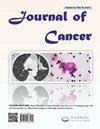PARK7是氧化应激相关乳腺癌风险的关键调节因子:一项多组学研究
摘要
背景:氧化应激(Oxidative stress, OS)与乳腺癌(breast cancer, BC)的发生和发展密切相关。然而,其作为潜在病因或触发因素的作用仍不清楚。本研究旨在通过整合多组学数据,系统探讨os相关基因在BC中的潜在因果效应及机制。方法:本研究从各自的数量性状位点(QTL)研究中获得了血液甲基化(mQTL)、基因表达(eQTL)、选择性剪接(sQTL)和蛋白质丰度(pQTL)的汇总数据。乳腺癌(BC)的遗传关联数据主要来自乳腺癌协会联盟(BCAC),并使用英国生物银行(UKB)和FinnGen数据库进行验证。采用SMR(基于摘要数据的孟德尔随机化)分析来评估氧化应激相关基因的分子特征与BC之间的关系。随后,进行共定位分析,以确定识别的信号是否具有相同的因果遗传变异。采用全转录组关联研究(TWAS)、全蛋白质组关联研究(PWAS)和多标记基因组注释分析(MAGMA)作为敏感性分析。此外,通过对潍坊中医院独立队列的血液样本进行多组学分析,验证了这些重要基因。结果:通过整合来自mQTL、eQTL、sQTL和pQTL分析的多组学数据,我们确定PARK7是一个关键的氧化应激相关基因,在多个水平上与乳腺癌(BC)存在显著关联。升高的PARK7基因表达(pSMR = 5.79E-06, OR = 0.91)和蛋白水平(pSMR = 8.46E-06, OR = 0.83)与降低BC风险显著相关。在mQTL分析中,cg10385390 (pSMR = 2.03E-03, OR = 1.09)和cg11518359 (pSMR = 3.54E-03, OR = 0.88)与BC显著相关。在sQTL分析中,PARK7 (chr1:7961793-7962763) (pSMR = 8.87E-06, OR = 1.03)和PARK7 (chr1:7961735-7962763) (pSMR = 9.38E-06, OR = 0.97)与BC显著相关。在mQTL-eQTL综合SMR分析中,cg10385390 (pSMR = 7.6e -15, OR = 0.47)和cg11518359 (pSMR = 4.56E-09, OR = 2.78)表现出显著相关性。在sQTL-pQTL综合SMR分析中,PARK7 (chr1:7961793-7962763) (pSMR = 4.622 -44, OR = 0.85)和PARK7 (chr1:7961735-7962763) (pSMR = 6.56E-42, OR = 1.19)均表现出显著相关性。这些发现揭示了PARK7通过氧化应激途径调控乳腺癌风险的多维分子机制。所有研究结果均得到共定位分析(PPH4 >.7)的支持。独立人群队列验证表明,乳腺癌患者血浆中PARK7 mRNA和蛋白水平显著低于健康对照组,与上述结果一致。结论:本研究创新性地整合了多组学数据,阐明了PARK7基因与乳腺癌风险之间的复杂关联,为乳腺癌的精准预防和靶向干预提供了新的见解。Background: Oxidative stress (OS) is closely associated with the occurrence and progression of breast cancer (BC). However, its role as a potential etiological factor or trigger remains unclear. This study aims to systematically investigate the potential causal effects and mechanisms of OS-related genes in BC by integrating multi-omics data. Methods: This study obtained summary data for blood methylation (mQTL), gene expression (eQTL), alternative splicing (sQTL), and protein abundance (pQTL) from their respective quantitative trait loci (QTL) studies. The genetic association data for breast cancer (BC) were primarily derived from the Breast Cancer Association Consortium (BCAC) and were validated using the UK Biobank (UKB) and FinnGen databases. SMR (Summary-data-based Mendelian Randomization) analysis was performed to evaluate the associations between the molecular characteristics of oxidative stress-related genes and BC. Subsequently, colocalization analysis was conducted to determine whether the identified signals share the same causal genetic variants. Whole-transcriptome association studies (TWAS), whole-proteome association studies (PWAS), and multi-marker analysis with genomic annotation (MAGMA) were used as sensitivity analyses. In addition, the significant genes were validated using multi-omics analysis of blood samples in an independent cohort from Weifang Traditional Chinese Medicine Hospital. Results: By integrating multi-omics data from mQTL, eQTL, sQTL, and pQTL analyses, we identified PARK7 as a key oxidative stress-related gene that showed significant associations with breast cancer (BC) at multiple levels. Elevated gene expression of PARK7 (pSMR = 5.79E-06, OR = 0.91) and protein levels (pSMR = 8.46E-06, OR = 0.83) were significantly associated with reduced BC risk. In the mQTL analysis, cg10385390 (pSMR = 2.03E-03, OR = 1.09) and cg11518359 (pSMR = 3.54E-03, OR = 0.88) were significantly associated with BC. In the sQTL analysis, PARK7 (chr1:7961793-7962763) (pSMR = 8.87E-06, OR = 1.03) and PARK7 (chr1:7961735-7962763) (pSMR = 9.38E-06, OR = 0.97) were significantly associated with BC. In the integrated mQTL-eQTL SMR analysis, cg10385390 (pSMR = 7.61E-15, OR = 0.47) and cg11518359 (pSMR = 4.56E-09, OR = 2.78) exhibited significant associations. In the integrated sQTL-pQTL SMR analysis, PARK7 (chr1:7961793-7962763) (pSMR = 4.62E-44, OR = 0.85) and PARK7 (chr1:7961735-7962763) (pSMR = 6.56E-42, OR = 1.19) both showed significant associations. These findings revealed the multidimensional molecular mechanisms by which PARK7 regulates breast cancer risk through the oxidative stress pathway. All findings were supported by colocalization analysis (PPH4 > 0.7). Validation in an independent population cohort indicated that plasma levels of PARK7 mRNA and protein in breast cancer patients were significantly lower than those in healthy controls, consistent with the aforementioned results. Conclusion: This study innovatively integrates multi-omics data to elucidate the complex associations between the PARK7 gene and breast cancer risk, providing new insights for precision prevention and targeted intervention of breast cancer.

 求助内容:
求助内容: 应助结果提醒方式:
应助结果提醒方式:


